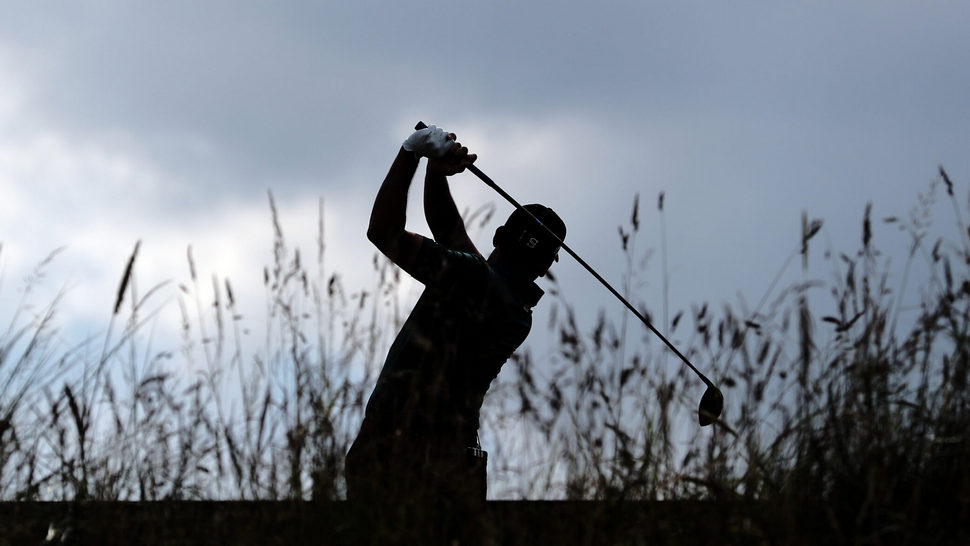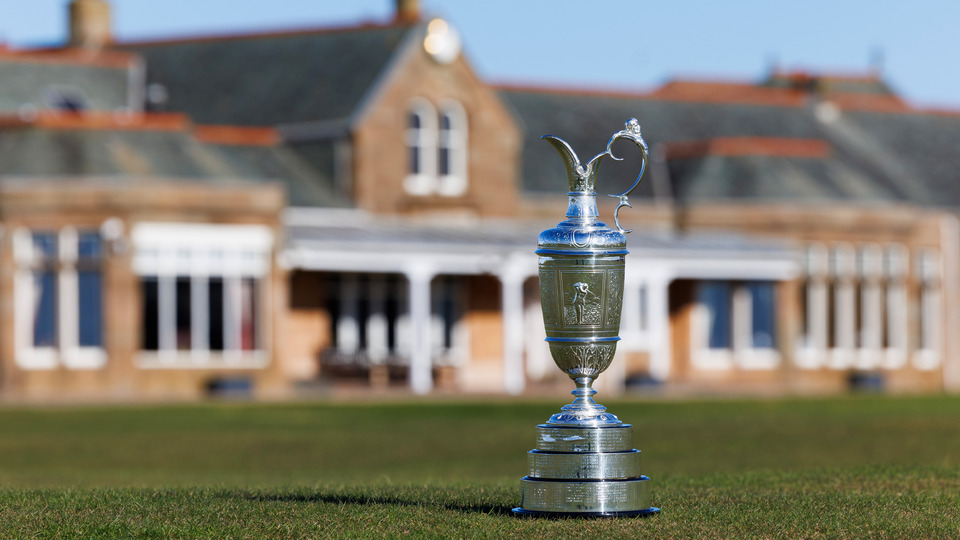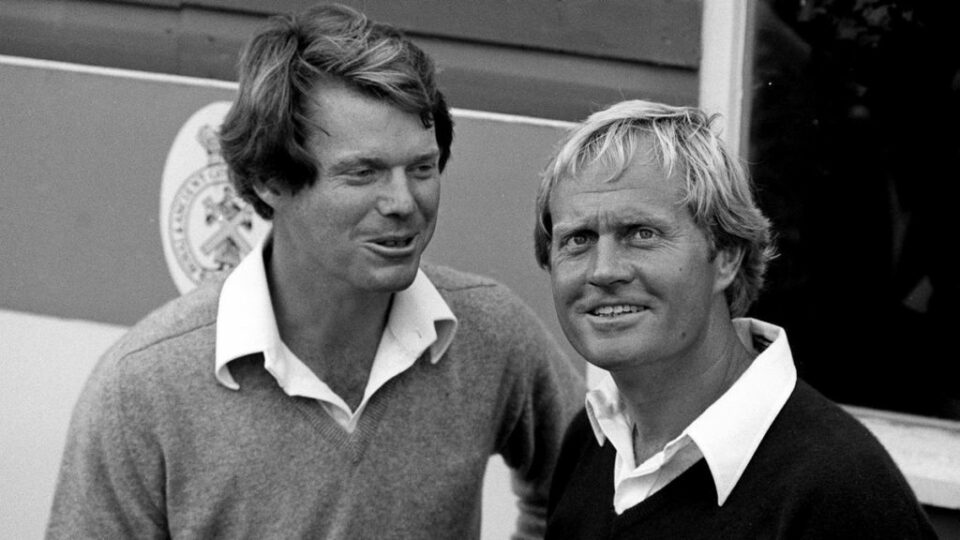If recovering from thick greenside rough is hard work, playing out of the sand is a day at the beach once you learn to appreciate the unique nature of impact…
By Sir Nick Faldo
The sounds of golf have always intrigued and inspired me. When I started out, the clatter of spikes from the locker room to the course was guaranteed to get the juices flowing – that unmistakable theme-tune announcing the game is about to begin. Opening a sleeve of balls still has that sense of anticipation about it. Ripping and tightening the velcro on your glove is the satisfying signal of intent as you survey a shot, and there’s nothing more dramatic than the speed and the compression of ball-then-turf as a top player strikes a long iron. I can remember my father taking to me to the Open at Troon in 1973 and me being mesmerised by the sound of Tom Weiskopf’s drives piercing the air as the ball rifled into the distance. (Has there ever been a better sound than the ‘thwack’ of persimmon on balata?)
Happily, the march of technology hasn’t dulled the airwaves entirely. For me, one of the greatest sounds (and feelings) in golf is experienced right here, in the sand. And recognising the speed, the fizz and the sheer gusto of a well-executed greenside bunker shot is elemental as we turn our attention to one of the most valuable skills in golf: the splash shot.
The key here lies in developing the confidence to accelerate the open face of your sand wedge beneath the ball to produce a shot that comes out softly with spin. And the secret is that you simply have to keep the clubhead moving, surfing it through the sand at speed as you accelerate to a finish. It’s rather like playing a good pitch shot, and we’re reminded here of why working on these specific skills is so beneficial for your full swing – you are cementing the relationship between your hands, arms and upper body over the balance and stability of your lower body. But the feeling here, with your feet shuffled into the sand, is that it’s all arms and upper body.

In many respects sand play remains a bastion of golf’s tradition, and the sound of a well-played shot hasn’t changed since the day Gene Sarazen came up with the idea of welding solder to the lower back of his wedge so that it sat lower than the leading edge, a modification he made in 1932 after observing the way the flaps on the wings of a light aircraft pushed wind down to help the plane go up. Sarazen’s genius (quite apart from that 4-wood he holed for ‘double-eagle’ at Augusta’s 15th en route to winning the 1935 Masters) was to similarly create a flange that would give the sand iron ‘lift’, or ‘bounce’ as it has became popularly known. Opening the face of the sand iron progressively increases this unique characteristic of what is a specialist club, and as long as you maintain your half of the bargain – that is, maintain speed through impact – you literally splash the ball out.
So go out and have some fun working on this part of your game. There’s no good reason why bunkers should make you fearful or cause you any problems. With a few simple drills you can learn to recognise the sound and the feel of a well-executed sand shot. And it’s addictive. The moment you experience the sensation and hear the sound of that first perfect sand shot, you will want to repeat it over and over again. And that’s a good thing. Practising your bunker play will make you a more aggressive wedge player because of the way you release the club and commit to striking through the shot.
Drill: Let the clubhead teach you good bunker technique
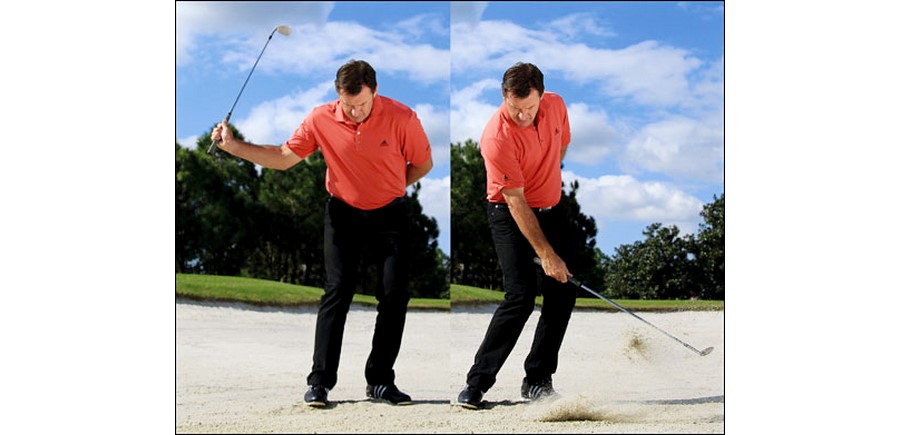
I could spend half an hour giving you the rundown on the details that I try to incorporate in good sand technique, but it wouldn’t add up to hill of beans compared to the feelings you can experience for yourself with a simple DIY lesson. Next time you go out to practice, try this experiment:
Spend the first two or three minutes swinging your sand wedge with your right hand only (left hand if you are a left-hander). Forget about a ball and focus instead on thumping the heavy flange through the sand. To do this you’ll first need to swivel the club through the fingers of your right hand to open the clubface. (If pointing the leading edge up vertically at 12 o’clock is your starting position, rotate it clockwise in your fingers until the leading edge points to around 2 o’clock.) Close your right hand grip with the face in that position, stand slightly open to the direction of your swing, and then focus on swinging the clubbed freely – feel the acceleration as you release the right hand, and listen to the sound you make.
As I mentioned a moment ago, the secret to playing these shots lies in delivering this speed through the sand. When you release your right hand correctly, the clubhead accelerates and that open clubface skims through the sand, producing a wonderfully distinctive sound. It won’t take you long to recognise the thrust of a good shot. The more you open the clubface, the more the bounce lifts the clubhead up and out of the sand – and the more satisfying the experience. Hold the club lightly in your fingers and you get a real sense of that acceleration as you let the club release past the hand. That’s the critical element of good bunker play – clubhead speed – and it comes from that acceleration and release of the right hand.
That’s what gives you the sound of success. Without even thinking about technique you are on the way to being a good bunker player.
Regular sand shot: Rotate and Release
In terms of your ability to keep a good score going, the greenside bunker shot could be the most important recovery in golf. As simple as this sounds, the way you form your grip holds the key. To access that magical element of ‘bounce’ you need to open the face of your sand wedge – and you must do this before completing your grip.
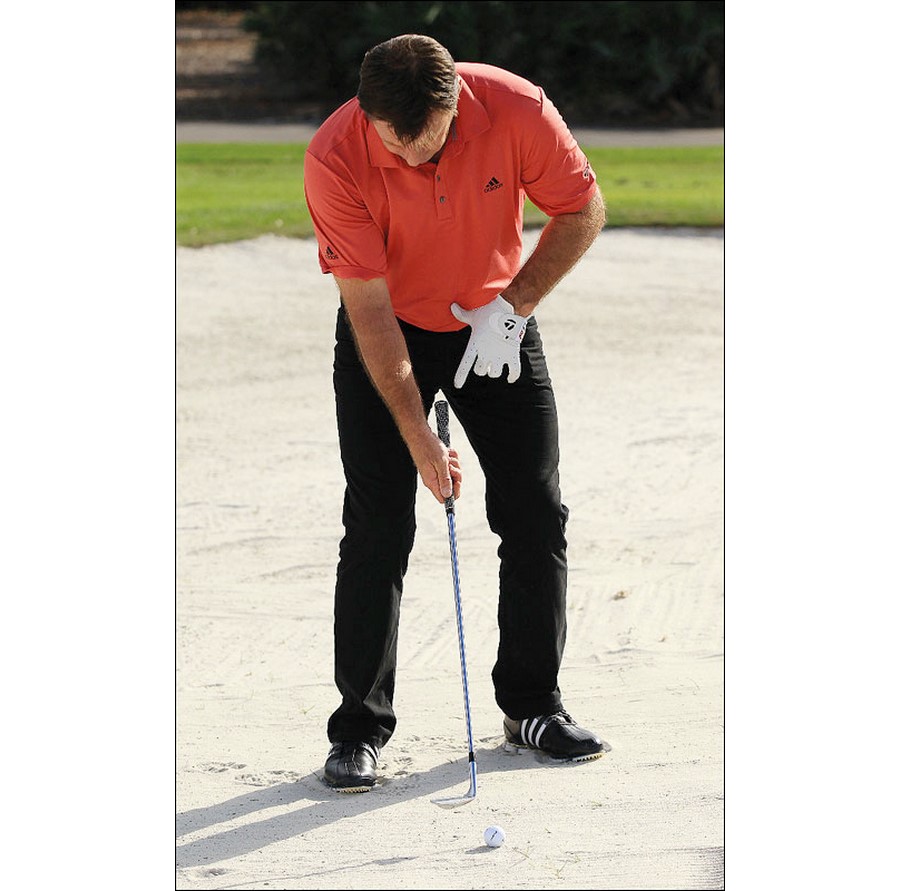
For a regular sand shot, I’d stand anywhere up to 30 degrees open to the target and settle down with my weight just favouring my left side. I flex the knees and gently shuffle my shoes into the sand until my body is nicely anchored. (Good bunker play is all about the arms and upper body; there is no weight shift to speak of and no need for any fancy footwork. But your body must gently unwind and get through to face the target.)
One of the best tips I've ever been given is to aim the butt-end of the club toward your belly button, which places the arms and hands in a nice neutral position in relation to the torso. The ball is played opposite the left instep. I then swivel the club through my fingers until the face is open in relation to my body, but square with the line to the flag. Once I’m happy with the position of the clubface, I complete my grip and get ready to play.

Having effectively preset good impact position, making the swing is relatively easy. You simply follow the line of your body. The clubhead leads, wrists and forearms rotate while the chest turns; on the way down, you reverse the sequence – chest turns, forearms and wrists release, and the clubhead skims through the sand. The key is to focus your eyes on a spot in the sand a couple of inches behind the ball – that's your point of entry – and then thump the sand with the bounce of the club (not the leading edge) on the way to your finish position. Keep your arms and wrists relaxed as you turn your shoulders back and through, and listen for that distinct sound as you release the club through to a balanced finish.
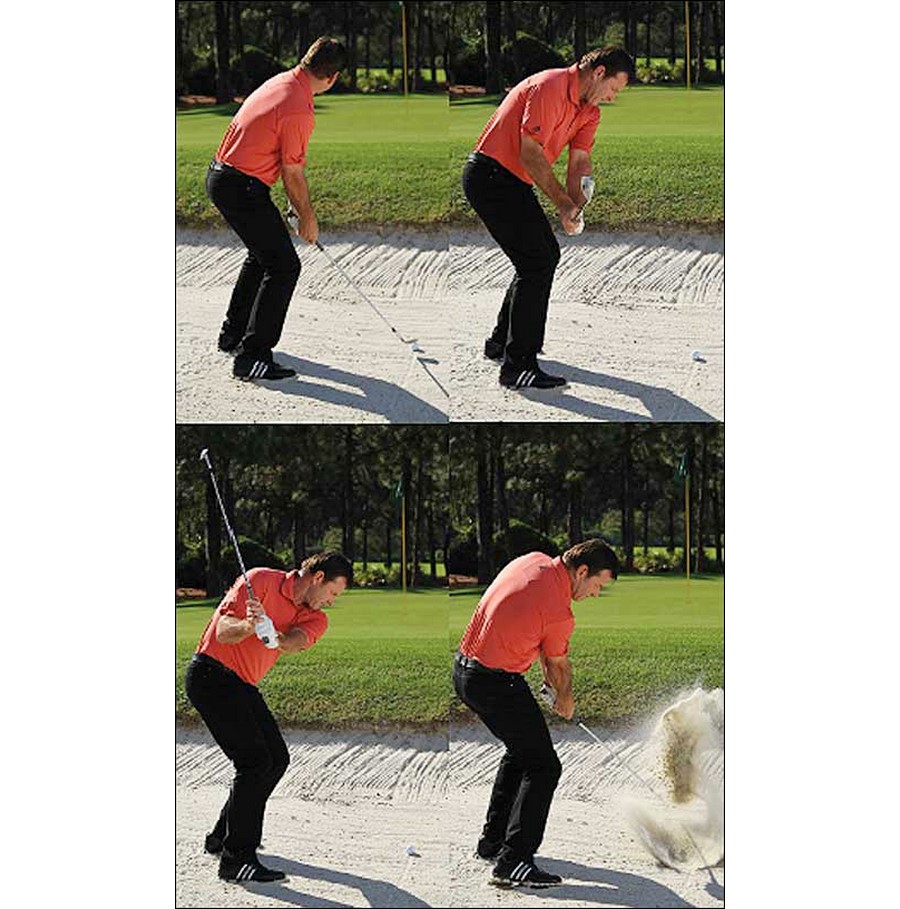
There’s no harm done if you watch the sand explode through impact. Don’t make the mistake of setting up to that point in the sand and then looking at the ball as you make your swing. You have to be 100% focused on exactly where you want the flange on your sand wedge to make contact with the sand. Developing good technique is all about being able to control the bottom of your swing arc, so focus on what you are aiming to hit. Once you have identified that spot in the sand, you can almost forget about the ball.
You’ll get the best results with the ball just forward of centre, so that you give yourself the time to extend your right arm fully as you skim the clubhead through the sand. This is all about speed in the clubhead – that’s how you generate the friction that creates backspin.
Drill: Find the line
To have absolute control in the sand, you need to get a feel, an awareness, for the bottom of your swing arc. And there’s no more effective way of doing that than spending time in a bunker working on the line drill. This has become one of my ‘standards’ for the way in which it quickly lets you how effectively you are repeating a good swing and taking a shallow and consistent cut of sand. If there’s a rake handy, press it into the sand to create a distinct straight line, and then spend a few minutes working your way along it, with your focus on making this your point of entry. Set up to the line just as you would set up to a ball, so it bisects your left heel, opening the clubface to utilise the bounce. Then simply work your way down the line, trying to thump it every single time.
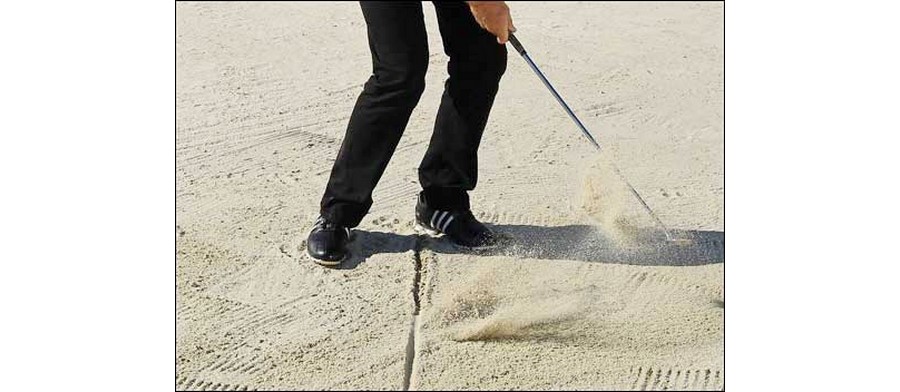
When I do this, I remind myself of the need to get the grip pointing at my belly button, while also making a point of levelling my shoulders (a common mistake being to ‘cramp’ the right side of the body; raising the right shoulder will help you to get the ball airborne more easily and hit it higher). It’s then all about the rotation of your upper body controlling the swinging of the arms until you can thump that line every time. After four or five swings, you should be looking at a neat row of divots, each one starting bang on that line.
(Simple diagnostics: When the club strikes the sand before the line, you are most likely using too much independent arm action; when you strike beyond the line, you are over-using your chest and upper body and looking up through impact).
Vary the length of your backswing and match it with the follow-through to regulate your speed and acceleration through impact. That’s both your volume and distance control. To fine-tune the distance you land the ball, try also gripping down the shaft. The combinations are endless. After a few minutes swinging on a level lie, move to the back of a bunker and make a fresh line on the downslope to create a new challenge; then move to the front of the bunker and test your ability to find your line on an uphill lie. This drill will give you all the feedback you need to adjust your body angles at the set-up – hip, shoulder, and spine angle – in readiness to swing either down or up the slope and find the line at impact.
The more time you spend in a bunker doing this, the better you'll get at controlling the delivery of the clubhead and hitting the sand exactly where you intend to. That’s the secret here – which is why the line drill is one of my absolute ‘musts’ for better sand play.
Drill: Release it with your right hand only

Here’s one for all you advanced players out there. How consistently can you play a good sand shot swinging with just the right hand? I love to do this, feeling the width of the swing and then allowing the clubhead to out-race the hand as I release the open clubface through the sand.
When you get it just right, the results are just as good as they are with two hands on the club, and you really do learn to appreciate the sensations of impact and the way speed and clubface angle combine to produce different shots. The key to doing this consistently is giving your right elbow the freedom it needs to work away from the body and really relaxing your grip pressure, which helps you to make a consistent backswing. The more relaxed your grip is, the more impact speed you will enjoy – which is also true in the swing generally.
Drill: Understanding lies and limitations
Control – that’s the key word. If there is a secret to a polished all-round short game it is understanding the way the ball reacts from different lies around the green and developing your clubhead awareness to such an extent that you are able to control impact. Sand shots are unique in that respect. Utilising the ‘bounce’, the idea here is that you use your sand iron to cut a shallow divot of sand from beneath the ball, and thus propel it into the air.

Early in my career I was fortunate to watch the great Gary Player put on a bunker show in which he used a simple drill to illustrate what you can expect to achieve out of different lies. It works like this: Arrange four balls in a line, each time making the lie slightly worse than the one before it; a perfectly ‘clean’ lie to a plugged ball. Then put the same swing on each one and see what you get. How far does each shot carry onto the green? How much does the ball run?
First, the clean lie. No problems here – you can play a regular splash shot with a wide open clubface and create a decent amount of backspin. With the ball in a slight depression, I’d again use an open clubface and play exactly the same shot, only this time I’d expect a slightly lower ball flight and the ball would run a little further on the green. The third ball in your line, the semi plugged, will come out lower and run further still, while fully plugged ball needs a good thump to pop it out, and will run the farthest.
The beauty of a drill like this is that you can use it to experiment with the variables you can control and use the feedback to understand the effect this has on the way each shot unfolds. I followed Gary’s example my whole career – and it will help you, too.
